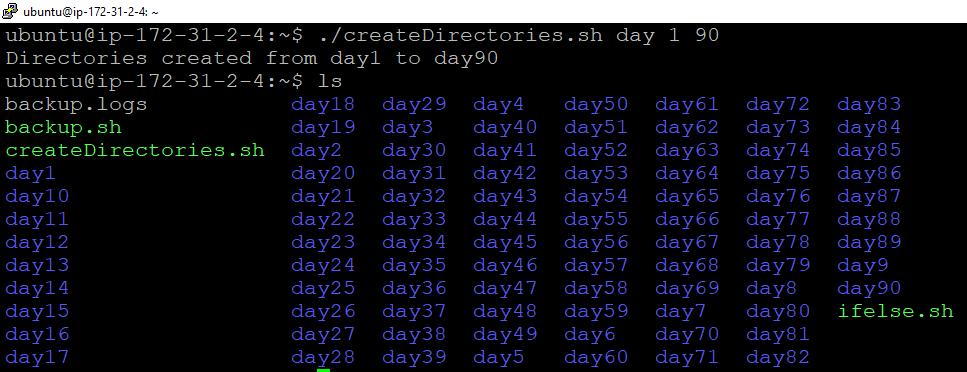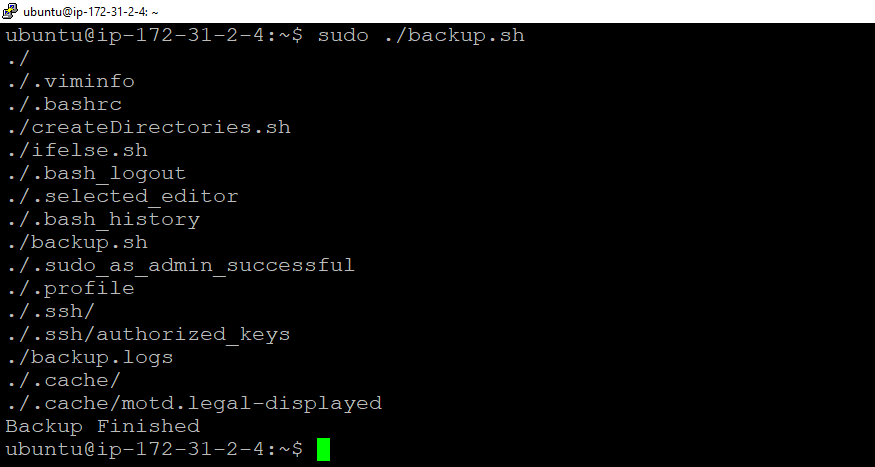Advanced Linux Shell Scripting for DevOps Engineers with User Management
 Imran Shaikh
Imran ShaikhCreate Directories Using Shell Script:
Write a bash script
createDirectories.shthat, when executed with three arguments (directory name, start number of directories, and end number of directories), creates a specified number of directories with a dynamic directory name.Example 1: When executed as
./createDirectories.shday 1 90, it creates 90 directories asday1 day2 day3 ... day90.Example 2: When executed as
./createDirectories.shMovie 20 50, it creates 31 directories asMovie20 Movie21 Movie22 ... Movie50.
#!/bin/bash
#Check number of arguments
if [ "$#" -ne 3 ]
then
echo "Enter valid arguments $0"
exit 1
fi
# Arguments stored in variables which is entered by user
dir_name=$1
start_num=$2
end_num=$3
#forloop to create directories
for ((i=start_num; i<=end_num; i++))
do
mkdir ${dir_name}${i}
done
echo "Directories created from ${dir_name}${start_num} to ${dir_name}${end_num}"
$# — Number of Arguments
$1 — First Arguments
$2 — Second Arguments
$3 — Third Arguments
Execution of Example 1:

Execution demo of Example 2:

- Create a Script to Backup All Your Work:
- Backups are an important part of a DevOps Engineer's day-to-day activities. (it can feel a bit difficult but keep trying, nothing is impossible).
#!/bin/bash
#Specify Path of Source Directory and store in Variable
backup="/home/ubuntu/"
#Specify Path of Destination Directory and store in Variable
dest="/imp/backup/"
#Create Directory as Destination Path
mkdir -p "$dest"
#Store date along with timestamp
day=$(date +%a-%d-%b-%y-%H%M)
#Store hostname without domain name
hostname=$(hostname -s)
#Assign backup file name
archive="$hostname-$day.tar"
#Create tar file
tar -cvf "$dest/$archive" -C "$backup" .
#Print message
echo "Backup Finished"
%a: represents the weekday name (e.g., Mon, Tue)%d: represents the day of the month (01 to 31)%b: represents the month name (e.g., Jan, Feb)%y: represents the last two digits of the year, such as 24 for the year 2024 (00 to 99)%H: represents the hour in 24-hour format (00 to 23).%M: represents the minute (00 to 59).
Execution of Script
—> Backup file will store in /imp/backup/

Cron and Crontab to Automate the Backup Script:
Cron is the system's main scheduler for running jobs or tasks unattended. A command called crontab allows the user to submit, edit, or delete entries to cron. A crontab file is a user file that holds the scheduling information.
Cron : Cron is daemon that executes scheduled commands. It also reads /etc/crontab
Crontab : Crontab is the program used to install, deinstall or list the table used to drive the cron
Check Cron table list by using following command:
#List the crontab
crontab -l
- Edit crontab by using following command:
#Edit crontab
crontab -e
- Delete crontab by using following command:
#To Delete crontab
crontab -r
- Cron Format :
Minute Hour Day of Month Month Day of Week Command/Script
(0-59) (0-23) (1-31) (1-12 or (0-6 or
Jan-Dec) Sun-Sat)
- User Management:
A user is an entity in a Linux operating system that can manipulate files and perform several other operations. Each user is assigned an ID that is unique within the system. IDs 0 to 999 are assigned to system users, and local user IDs start from 1000 onwards.
Creating users:
#!/bin/bash
#Create user
useradd imran
useradd shaikh
#Display created users
sudo cat /etc/shadow | grep -i imran
sudo cat /etc/shadow | grep -i shaikh
Output:

Happy Learning:)
Subscribe to my newsletter
Read articles from Imran Shaikh directly inside your inbox. Subscribe to the newsletter, and don't miss out.
Written by
